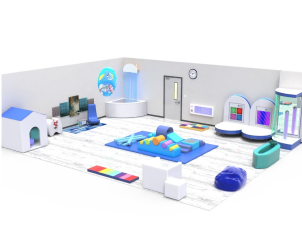Teaching and administering during a time when sensory integration, ADHD, Autism and a variety of other neurological differences are prevalent leads us as parents, teachers and administrators to re-think our classroom designs. You want a school that understands EVERY child and can accommodate them to be able to learn at their potential. This means that we need to reconsider how our classrooms are structured. Take a look at some terrific ideas for setting up a classroom for kids with Autism. You may be surprised to find out that even your neurotypical kids would benefit from some environmental changes. We'd love to hear about your classroom designs and what you've done to accommodate children with special needs.
1) Visual Organizers: If you have kids on the spectrum, you MUST consider the visual appearance of your classroom and the visual impact it may have on your children. There should be clear signs in your classroom designating schedules. Signs can also be used for lists or rules or homework. Consider using visual timers such as a large Time Timer as well. Also consider minimizing visual distractions such as an overcrowded wall, bright colors or dizzying carpets. Keep it simple, clean and calm.
2) Low Lighting: Along the same lines as visual organizers is low lighting. Make sure if you have fluorescent lights, that they are turned off or covered by light covers. You can replace these lights with halogen lamps if permitted or low-level lighting. Fluorescent lights actually give off a buzz and children on the spectrum hear it and often cannot filter it out.
3) Aromatherapy: This is more than just stopping to smell the roses. Aromatherapy is highly effective for either calming (scents like lavender or sage) or alerting (scents like peppermint or citrus). Get a good diffuser and use this indispensable tool to enhance your classroom productivity.
4) Sound: Step into your classroom when no one is there and listen. What do you hear? Your kids with autism will hear it 10x louder. Is there noise in the halls, buzzing from the lights, humming from the air conditioner? You may want to consider piping in some classical Mozart music or a white noise machine to buffer some of the erroneous sounds.
5) Office Space and Personal Space: Children on the spectrum often do not understand personal space and yet they crave it. Provide boundaries whether it is desktop carrels for providing and "office space," spots on the floor for sitting space, or placemats around a table for providing personal workspace.
6) Seating Solutions: Consider providing wiggle cushions or ball chairs to encourage active and engage students, beanbags or pillows for your reading corner and floor mats or floor cushions for floor time. Watch how your kids sit. Are they leaning back, slumped over, falling out of their chairs? Consult with a physical therapist who can help you find the perfect solution for your classroom or child.
7) Heavy Work Time: Is there a space for movement in your classroom? Provide your kids with a heavy work area using a weighted ball or weights. Use resistance band and place it at the foot of their chairs to keep their feet busy. Provide squeeze balls or putty for heavy handwork and stress reduction. Encourage parents to send in "crunchy' snack foods to keep everyone's jaw and mouth calm. If you have kids with a lot of oral motor issues, I would even ask parents to provide a personal chewy. Chewing has shown to increase test scores and heighten awareness.
8) Sensory Stations: Do you have a Break Box in your classroom, a sensory corner or chill area? Consider getting a Break Box and allowing kids break times to find what works for their own personal sensory system.
9) Clear Communication: Make sure your parents are on board with you and that you are in regular communication with them in regards to your classroom set up as well as any individual concerns. Each child should be part of the teacher-parent-child team where each part of the team has an opportunity to communicate on a regular basis.
With just a few subtle changes your classroom can accommodate everyone on the spectrum and encourage active learning!
Check out our sensory tools to support students with autism.



















Comments